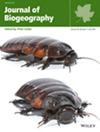Evolutionary causes of global patterns of species richness in regional fern floras across the world
Abstract
Aim
Globally, biodiversity is unevenly distributed, as a result of varying environmental conditions and regionally different historical processes. The influence of the latter on current diversity patterns is poorly understood. We explore geographic patterns of matches and mismatches between phylogenetic relatedness metrics measuring different depths of evolutionary history and investigate the effects of evolutionary legacy at different evolutionary depths on species density of ferns.
Methods
We divided the globe into 392 geographic regions on land, and collated species lists of ferns for each geographic region. We related species richness to phylogenetic metrics reflecting different depths of evolutionary history (standardized effect sizes of mean nearest taxon distance and mean pairwise distance, MNTDses and MPDses, respectively) for ferns in regional floras across the world.
Location
Global.
Time Period
Current.
Taxon
Ferns.
Results
We show that different centers of fern diversity have strikingly different phylogenetic composition. We find that overall fern species diversity is negatively correlated with both MNTDses and MPDses, so that regions with high species diversity tend to have clustered species assemblages, whereas species-poor regions tend to have overdispersed species assemblages. At the global extent, MNTDses and MPDses together explained 62.2%, 19.3%, and 65.7% of the variation in species diversity for all ferns as a whole, non-polypod ferns, and polypods, respectively.
Main Conclusions
Our study suggests that current geographic patterns of fern species richness are driven, at least in part, by evolutionary history of ferns, which varies among biogeographic regions.

 求助内容:
求助内容: 应助结果提醒方式:
应助结果提醒方式:


